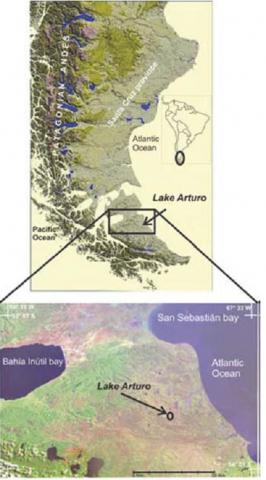María Julia Orgeira, Carlos Alberto Vásquez, Andrea Coronato, Juan Federico Ponce, Alicia Moreto, Margarita Osterrieth, Ramon Egli and Romina Onorato
2 012
Revista de la Sociedad Geológica de España 25 (1-2)
Esta contribución incluye los resultados preliminares del estudio de magnetismo ambiental de 80 niveles muestreados en una secuencia de sedimentos eólicos limosos con 8 paleosuelos intercalados.
De acuerdo a las dataciones 14C disponibles la secuencia estudiada contiene registro geológico de todo el Holoceno. Los resultados incluyen principalmente parámetros magnéticos obtenidos en magnetómetro
vibrante a temperatura ambiente, susceptibilidad magnética a dos frecuencias y determinaciones de susceptibilidad a altas y bajas temperaturas. Los resultados aquí discutidos, sumados a los de otros proxie climáticos, definen una alta variabilidad climática a estas latitudes de América durante el lapso estudiado. Un periodo de mayor humedad que la actual se insinúa a través de los parámetros magnéticos durante el período representado por cuatro paleosuelos desde el Holoceno medio al tardío; estos son P7 (471 años BP), P5 (5552 años BP), P4 (6538 años BP) y P2 (edad entre 7163 y 11308 años BP).
De acuerdo a las dataciones 14C disponibles la secuencia estudiada contiene registro geológico de todo el Holoceno. Los resultados incluyen principalmente parámetros magnéticos obtenidos en magnetómetro
vibrante a temperatura ambiente, susceptibilidad magnética a dos frecuencias y determinaciones de susceptibilidad a altas y bajas temperaturas. Los resultados aquí discutidos, sumados a los de otros proxie climáticos, definen una alta variabilidad climática a estas latitudes de América durante el lapso estudiado. Un periodo de mayor humedad que la actual se insinúa a través de los parámetros magnéticos durante el período representado por cuatro paleosuelos desde el Holoceno medio al tardío; estos son P7 (471 años BP), P5 (5552 años BP), P4 (6538 años BP) y P2 (edad entre 7163 y 11308 años BP).
In this contribution we present preliminary environmental magnetism results from 80 samples
collected along an eolian sedimentary sequence with 8 interbedded paleosols. 14C data indicates that
the studied record represents the Holocene.The results principally include hysteresis data at room temperature,
variation of magnetic susceptibility at two frequencies, and susceptibility at high and low temperatures
in selected samples. The results discussed here suggest that the humidity during the formation
of the studied paleosols was variable for each one. This means the alternating of wet and dry periods
throughout the entire Holocene have been of different intensities. The magnetic results, together with
some other properties of the geological record define a high climate variability occurring in the southern
extremity of the Americas. A period of higher humidity than the present is suggested by the magnetic
parameters during the period represented by the paleosols P7 (471 yrs BP), P5 (5552 yrs BP), P4 (6538
yrs BP) and P2 (age between 7163 and 11308 yrs BP).
collected along an eolian sedimentary sequence with 8 interbedded paleosols. 14C data indicates that
the studied record represents the Holocene.The results principally include hysteresis data at room temperature,
variation of magnetic susceptibility at two frequencies, and susceptibility at high and low temperatures
in selected samples. The results discussed here suggest that the humidity during the formation
of the studied paleosols was variable for each one. This means the alternating of wet and dry periods
throughout the entire Holocene have been of different intensities. The magnetic results, together with
some other properties of the geological record define a high climate variability occurring in the southern
extremity of the Americas. A period of higher humidity than the present is suggested by the magnetic
parameters during the period represented by the paleosols P7 (471 yrs BP), P5 (5552 yrs BP), P4 (6538
yrs BP) and P2 (age between 7163 and 11308 yrs BP).

